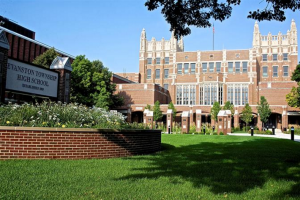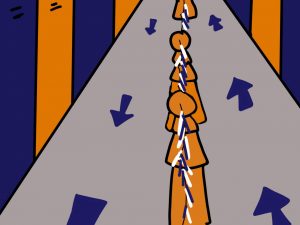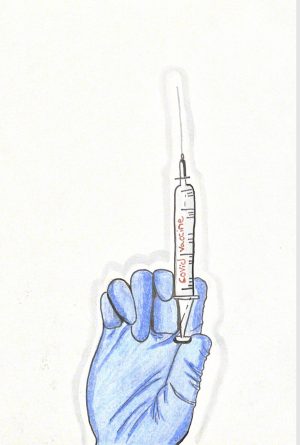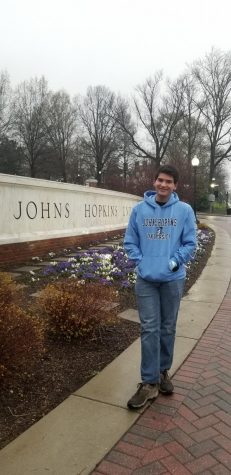Teachers react to in-person announcement
March 22, 2021
On March 1, ETHS announced its plan to begin hybrid learning on April 14. Coming almost 13 months to the day after the COVID-19 pandemic forced a nationwide shutdown that, among everything else, impacted ETHS, hybrid learning marks a major shift in the transition back to full in-person learning. With such a significant change, it should come as no surprise that there has been a wide range of reactions to the news across the many affected groups—students, parents and, of course, teachers.
At the March 8 District 202 School Board meeting, 27 teachers and staff members submitted public comments explaining their thoughts and beliefs regarding the hybrid transition. While each and every one of these comments is distinct, and this set of letters in no way represents the opinions of every teacher, four major concerns surrounding hybrid emerged: that it won’t increase student learning or mental health as promised, that it won’t be safe for students or staff, that it goes against ETHS’s work towards equity and that there hasn’t been adequate community input.
Impacts on Student Learning
“Our ETHS students aren’t going to benefit from the hybrid model and will, in fact, be harmed by it. I agree with Dr. Witherspoon in the 12/18 E-Town Live when he said, ‘We’ve come to understand that if in-person is the best, the second-best is to actually be on remote, which we’ve been on, and the third-best is the hybrid model.’ I can’t imagine why he would say that and then make the unilateral decision that he’s just made,” a letter submitted by English teachers Anita Bucio, Tara Pollock and Paola Ruocco, French teacher Ashlee Cummings, history teacher Sabrina Ehmke, German teacher Edward Gray, math teachers Maryjoy Heineman and Margaret Petrof, Spanish teachers Kattie Kelly, Gabriela Perez and Lindsay Shiltz, head librarian William Latham and testing coordinator Anya Pierce wrote. “Remote learning is certainly not perfect, but I worry that my students will miss out on even more learning if we switch to a hybrid model. No one thinks this is academically beneficial for students; yet for some reason, the Superintendent has decided that this is the best course of action.”
Students will lose instructional time due to the switch to hybrid. Not only will all periods be shorted by five minutes, from 70 minutes to 65 minutes to allow for a longer lunch break, but two school days, April 8-9, are now being used as planning days. This is in addition to time lost due to standardized tests such as the SAT that some students will be taking on April 13 and AP Exams.
Even ignoring the matter of lost time, many feel that the hybrid model will not provide the educational opportunities that the administration claims it will have.
“I am eager to have my students in my classroom. I want to do labs with equipment that cannot be sent home… However, I also want to make sure that being in person will provide more than Zoom with legs, and will not result in a disadvantage to my students who are at home,” biology and forensics teacher Hunter Young wrote.
“Everyone will be on their laptops. There will be no group work or socialization opportunities. There will be no catching up in the hallway, or study hall gatherings. There is no lunch period. I will see students who choose hybrid in class twice a month; three times total before graduation! This is not the good old days. This is not good educationally. Why would any student choose this form of education to finish their year?” history teacher David Allen wrote. “The answer is they wouldn’t and are not in enormous numbers. Many other North Shore high schools that have gone this route have seen their attendance crater as students experience these realities. Whatever student numbers ETHS solicits as returning to in-person learning will not hold after the first week.”
ETHS under hybrid learning will be what Bucio et al describe as a “cold, impersonal environment… to do remote learning. “ This is a stark contrast to the sole listed benefit of the hybrid model: “personal connection with staff and social interactions with peers.”
Student and Staff Safety
While learning is essential, there is nothing more important in a pandemic than ensuring safety, another major point of contention that teachers had with the school’s plan.
“I am concerned that not all teachers and staff members at ETHS will have had the chance to be immunized if they choose to do so. Just this past week alone, two of my students shared with me that they were COVID positive and another shared that her beloved grandma was diagnosed with COVID. Like many of my colleagues, I teach in a classroom at ETHS that does not have any windows at all. Had we been in the classroom, my students and I would have been exposed to COVID three times in this past week,” English teacher John Kennedy-Farrell wrote.
The fear of infection is increased by the distribution of vaccines. With more people getting vaccinated every day, each day without COVID is one day closer to potentially never contracting it. Yet, many teachers, and students, remain unvaccinated.
“Many teachers are reasonably concerned about vaccine availability, efficacy and building safety in a poorly-ventilated building with teens who are not required to be vaccinated… It’s common for kids to attend school with the flu, and the same will be true for COVID, which, unlike flu, can even be non-symptomatic. Many staff including myself, were vaccinated for the flu last year and got it anyway. I had a serious case and ended up with pneumonia and a collapsed lung,” English teacher Erica Thompson wrote.
“Many of our faculty and staff are still not vaccinated. It is extremely difficult to find vaccine appointments. Some neighboring schools were able to work with local health officials and get their employees vaccinated. However, ETHS was not able to do this. Why are we not waiting for everyone to be vaccinated?” English teacher Sara Young wrote.
While there may have been a boost in vaccinations following a mass vaccination event at Maine South on March 21, the road to vaccination has been bumpy; for more information read “ETHS works to vaccinate teachers before hybrid learning begins” on Page 5.
Lastly, unlike students, teachers were not offered the opportunity to opt-out of a return to in-person instruction for any reason, which several teachers feel is a breach of the “family” that ETHS claims to foster.
“ETHS is offering families with children who attend the high school an option: engage in hybrid learning or remain remote. No explanation needed…. Since we hear often that ETHS is a family—not simply workers or employees, but family—we must conclude that the same option, hybrid or remote, will be offered to everyone in the ETHS family: teachers, faculty and staff included,” English teacher Evan Belgrade wrote.
“Dr. Witherspoon often likes to refer to the school community as a family, yet I believe his actions leading up to his decision are the polar opposite of how to treat a family member. The staff is a large part of the ETHS family, and Dr. Witherspoon never asked us for our opinions about going back to school for hybrid learning. Had he chosen to question us, as our union did, he would have found a great many members of this family have serious concerns about basic needs like childcare or the lack of fresh air for their classrooms. Why did Dr. Witherspoon not choose to hear from this wing of the family? Why has the school not made an organized effort to vaccinate the staff and keep the family safe?” math teacher Andrew Segall expressed.
Issues of Equity
The final major concern regarding hybrid instruction is one of equity. ETHS’s mission statement expresses that it is “committed to educating all of its students to their maximum potential,” a commitment that “requires not only respect for the differences in students and staff from widely diverse social, economic, cultural, linguistic, intellectual, racial, educational, and religious backgrounds, but also a sustained effort to use that diversity to fulfill its commitment.”
Despite this commitment, many feel that the hybrid model will harm Black and brown communities far more than it will help them.
“Most students have now adapted and feel comfortable with remote learning. Some are even thriving—and many of my thriving students are students of color. I’ve also heard stories from ETHS colleagues about students of color flourishing this year; a spate of recent articles confirm this phenomenon as well (see, e.g. “For Some Black Students, Remote Learning Offers an Opportunity to Thrive”). Staying the course remotely this year will provide us with valuable data to move our equity mission forward. Let’s not abort that mission now,” Thompson wrote.
“We know that systemic barriers that permeate housing, healthcare, education, economics, policing and government policies harm our Black and Brown communities by disproportionate amounts. It is the school’s responsibility to protect our most vulnerable as a community, and this will be the best in the long-run for all,” English teacher Angela Sangha-Gadsden wrote.
As Sangha-Gadsden mentions, COVID-19 has disproportionately struck communities of color. According to The COVID Racial Data Tracker at The Atlantic, Black and Indigenous people have died at 1.4 times the rate of white people, and Hispanic and Latino communities at 1.2 times that of white communities. Put differently, 15 percent of COVID-19 deaths where race is known were Black deaths. Bringing students back to the building might only increase this disparity.
“This hybrid model will put Black and Latino students and employees at greater risk for contracting this disease. Personally, I have been affected by COVID-19 because 22 people in my family have contracted COVID-19 during this global pandemic. It is important that as a community we acknowledge the racial disparity that exists for this disease and do what is best for the entire community. In this decision, there should be strong consideration for the health and safety of our Black and Latino families. ETHS promotes equity… however, this decision supports those with the most privilege,” English teacher Deshana Newman states.
Beyond the illness itself, the demographics of ETHS will drastically shift under the hybrid return with 68 percent of hybrid students identifying as white (compared to 46 percent of the total student body) and 79 percent of Black students opting to remain remote. This shift is a direct result of those who most advocating for a return to school: white parents.
“Instead of collecting data from our entire community, the Superintendent has decided to cave-in to pressure from a loud, well-organized group of parents who do not represent the entire ETHS community. Where are the voices or parents of color? Or parents of students with disabilities? What do our students want from a return to in-person instruction? I don’t believe that we have answers to these questions because we haven’t asked. The Superintendent has decided to honor the voices of the privileged instead of seeking the voices of the entire community. I cannot support that kind of decision making, especially when I thought our school stood for equity and raising up the voices of the historically silenced,” Bucio et al. expressed.
“A historical moment when a small minority of the privileged are seeking to advance their own interests…. This single-issue group’s demand to return without reflection to an inequitable past has now likely derailed [the voluntary Monday plan aimed at addressing student mental health] because teachers will be consumed with how to teach hybridly, how to demonstrate and perceive emotions through masks, and how to project our muffled voices to our remote students, all while worrying about infection and risk to our ETHS family,” Thompson shared. “These vocal, reactionary parents shout to send us back—and make no mistake; the shrill voices of white privilege in this community want to send us back… It’s naive to think the reopen group will be appeased by hybrid, particularly if we do it this year. It will merely give them fodder to push for a full and reckless in-person return before it is safe to do so.”
“My perception is that Dr. Witherspoon listened to the small, vocal, entirely white group of parents who have (successfully) pushed schools to reopen in Evanston,” Segall wrote. “In the absence of any other markers, perception shapes reality, and Dr. Witherspoon’s decision flies in the face of the equality message that the school has worked so hard to promote.”
One way or another, ETHS will be opening its doors wider than it has in the last year, all that remains to be seen is what awaits on the other side of those orange-and-blue doors.














